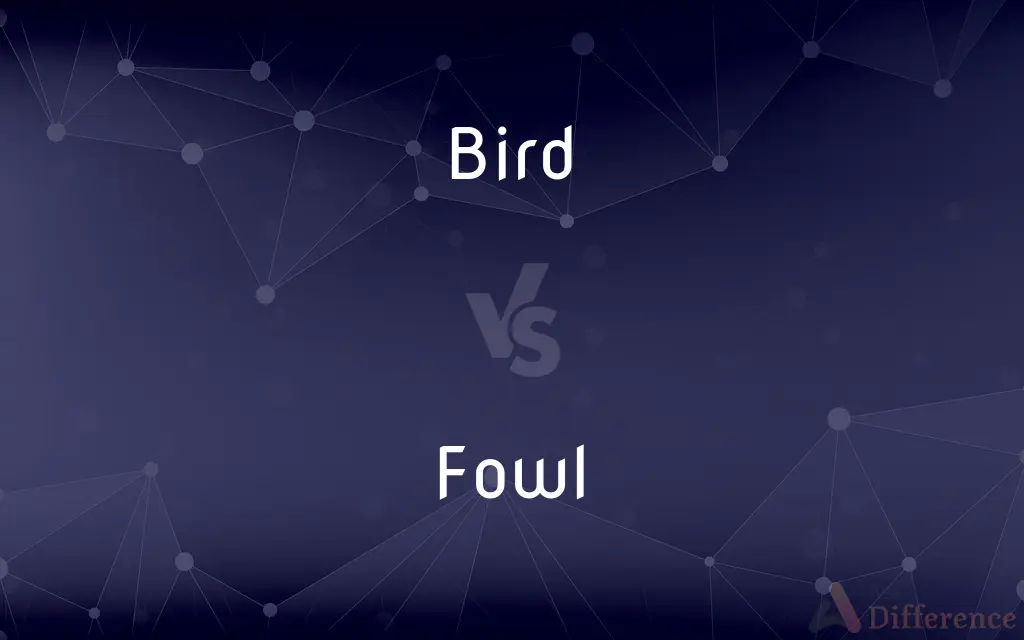Bird vs. Fowl — What's the Difference?
By Tayyaba Rehman & Maham Liaqat — Updated on March 25, 2024
Birds encompass wide range of feathered creatures, from tiny hummingbirds to large ostriches, characterized by their ability to fly, though not all birds do. Fowl generally refers to domesticated birds raised for eggs, meat, or feathers.

Difference Between Bird and Fowl
Table of Contents
ADVERTISEMENT
Key Differences
The term "bird" is an all-encompassing descriptor for members of the class Aves, which includes a vast diversity of species with feathers, beaks, and, in most cases, the ability to fly. Fowl, on the other hand, narrows this broad category down to birds that are specifically raised for human use, primarily in agriculture. This distinction places wild and exotic birds under the "bird" category, while "fowl" captures those species like chickens, ducks, and turkeys that have been domesticated for consumption or farming purposes.
Birds are celebrated for their ecological roles, such as pollination, seed dispersal, and pest control, as well as their aesthetic appeal through birdwatching and conservation efforts. Fowl, while they can possess some of these ecological roles, are more so valued for their economic and dietary contributions to human societies. The focus with fowl is on their productivity in terms of meat, eggs, and feathers rather than their roles in natural ecosystems.
The ability to fly is a defining characteristic of many bird species, showcasing the evolutionary marvel of avian flight. However, not all birds can fly; this trait is irrelevant when it comes to fowl, as many domesticated birds are bred for traits beneficial to agriculture, such as size or egg-laying capacity, often at the expense of their ability to fly.
Conservation efforts are frequently directed towards birds, especially those that are endangered or play crucial roles in their ecosystems. Fowl species, due to their domesticated status, are subject to agricultural practices and breeding for yield, with less emphasis on preserving their natural state or biodiversity.
The distinction between birds and fowl underscores the difference between the entire class of Aves and the subset of birds that humans have domesticated for agricultural purposes. This division highlights not only biological differences but also the varied relationships between humans and these creatures.
ADVERTISEMENT
Comparison Chart
Definition
All members of the class Aves, characterized by feathers, beaks, and typically the ability to fly.
Domesticated birds raised for consumption, eggs, or feathers, such as chickens and turkeys.
Types
Includes a wide range of species from hummingbirds to ostriches.
Primarily includes chickens, ducks, turkeys, and geese.
Purpose
Ecological roles, aesthetic appeal, and conservation.
Raised for meat, eggs, and feathers; agricultural purposes.
Ability to Fly
Many species can fly, though not all.
Often limited by domestication and selective breeding.
Conservation
Many species are the focus of conservation efforts due to their roles in ecosystems.
Less focus on conservation, more on productivity and breeding.
Compare with Definitions
Bird
An object of fascination and study in ornithology.
Birdwatching has become a popular way to connect with nature.
Fowl
Often includes species like chickens, turkeys, and ducks.
Fowl such as turkeys are raised for holiday feasts.
Bird
Many species participate in migration.
Arctic terns are birds that undertake the longest migrations.
Fowl
Breeding focuses on productivity traits.
Selective breeding has increased the egg-laying capacity of some fowl.
Bird
Creatures belonging to the class Aves.
Birds are known for their diverse range of vocalizations.
Fowl
Part of agriculture and farming practices.
Raising fowl is an essential aspect of sustainable farming for many communities.
Bird
Distinguished by their feathers, beaks, and egg-laying.
All birds lay eggs, but their nesting habits vary widely.
Fowl
Domesticated birds kept for eggs or meat.
Chickens are the most common type of fowl found on farms.
Bird
Any of a large group of feathered, winged animals, most of which can fly.
The robin is a bird commonly seen in gardens.
Fowl
Can refer to both individual birds and the meat derived from them.
Roast fowl is a staple in many culinary traditions.
Bird
Birds are a group of vertebrates constituting the class Aves , characterised by feathers, toothless beaked jaws, the laying of hard-shelled eggs, a high metabolic rate, a four-chambered heart, and a strong yet lightweight skeleton. Birds live worldwide and range in size from the 5.5 cm (2.2 in) bee hummingbird to the 2.8 m (9 ft 2 in) ostrich.
Fowl
Fowl are birds belonging to one of two biological orders, namely the gamefowl or landfowl (Galliformes) and the waterfowl (Anseriformes). Anatomical and molecular similarities suggest these two groups are close evolutionary relatives; together, they form the fowl clade which is scientifically known as Galloanserae (initially termed Galloanseri) (Latin gallus (“rooster”) + ānser (“goose”)).
Bird
A person of a specified kind or character
She's a sharp old bird
Fowl
A gallinaceous bird kept for its eggs and flesh; a domestic cock or hen.
Bird
A young woman or a girlfriend.
Fowl
Any of various birds of the order Galliformes, especially the common, widely domesticated chicken (Gallus domesticus).
Bird
Such an animal hunted as game.
Fowl
A bird, such as a duck, goose, turkey, or pheasant, that is used as food or hunted as game.
Bird
Such an animal, especially a chicken or turkey, used as food
Put the bird in the oven.
Fowl
The flesh of such birds used as food.
Bird
See clay pigeon.
Fowl
A bird of any kind.
Bird
(Sports) See shuttlecock.
Fowl
To hunt, trap, or shoot wildfowl.
Bird
(Slang) A rocket, guided missile, satellite, or airplane.
Fowl
(archaic) A bird.
Bird
(Slang) A person, especially one who is odd or remarkable
A sly old bird.
Fowl
A bird of the order Galliformes, including chickens, turkeys, pheasant, partridges and quail.
Bird
Chiefly British Slang A young woman.
Fowl
Birds which are hunted or kept for food, including Galliformes and also waterfowl of the order Anseriformes such as ducks, geese and swans, together forming the clade Galloanserae.
Bird
A loud sound expressing disapproval; a raspberry.
Fowl
To hunt fowl.
We took our guns and went fowling.
Bird
Discharge from employment
Lost a big sale and nearly got the bird.
Fowl
Any bird; esp., any large edible bird.
Let them have dominion over the fish of the sea, and over the fowl of the air.
Behold the fowls of the air; for they sow not.
Like a flight of fowlScattered by winds and high tempestuous gusts.
Bird
An obscene gesture of anger, defiance, or derision made by pointing or jabbing the middle finger upward.
Fowl
Any domesticated bird used as food, as a hen, turkey, duck; in a more restricted sense, the common domestic cock or hen (Gallus domesticus).
Bird
To observe and identify birds in their natural surroundings.
Fowl
A domesticated gallinaceous bird though to be descended from the red jungle fowl
Bird
To trap, shoot, or catch birds.
Fowl
The flesh of a bird or fowl (wild or domestic) used as food
Bird
A chicken or turkey used as food.
Pitch in and help me stuff the bird if you want Thanksgiving dinner.
Fowl
Hunt fowl
Bird
(slang) A man, fellow.
Fowl
Hunt fowl in the forest
Bird
A girlfriend.
Mike went out with his bird last night.
Bird
(slang) An airplane.
Bird
(slang) A satellite.
Bird
(obsolete) A chicken; the young of a fowl; a young eaglet; a nestling.
Bird
Booing and jeering, especially as done by an audience expressing displeasure at a performer.
Bird
(with definite article) The vulgar hand gesture in which the middle finger is extended.
Bird
A yardbird.
Bird
A kilogram of cocaine.
Bird
(slang) A prison sentence.
He’s doing bird.
Bird
(intransitive) To observe or identify wild birds in their natural environment.
Bird
(intransitive) To catch or shoot birds; to hunt birds.
Bird
To seek for game or plunder; to thieve.
Bird
To transmit via satellite.
Bird
To bring into prison, to roof.
Bird
Able to be passed with very little work; having the nature of a bird course.
Bird
Orig., a chicken; the young of a fowl; a young eaglet; a nestling; and hence, a feathered flying animal (see 2).
That ungentle gull, the cuckoo's bird.
The brydds [birds] of the aier have nestes.
Bird
Specifically, among sportsmen, a game bird.
Bird
Fig.: A girl; a maiden.
And by my word! the bonny birdIn danger shall not tarry.
Bird
To catch or shoot birds.
Bird
Hence: To seek for game or plunder; to thieve.
Bird
To watch birds, especially in their natural habitats, for enjoyment; to birdwatch.
Bird
The flesh of a bird or fowl (wild or domestic) used as food
Bird
Informal terms for a (young) woman
Bird
A cry or noise made to express displeasure or contempt
Bird
Badminton equipment consisting of a ball of cork or rubber with a crown of feathers
Bird
Watch and study birds in their natural habitat
Common Curiosities
Are all birds capable of flying?
No, not all birds can fly; some species have evolved other means of locomotion, like running or swimming.
Is the term 'poultry' synonymous with fowl?
Yes, "poultry" is often used interchangeably with "fowl" to refer to domesticated birds raised for their meat, eggs, and feathers.
What are some common characteristics of birds?
Common characteristics include feathers, beaks, the laying of eggs, and in many cases, the ability to fly.
What makes a bird a fowl?
A bird is considered a fowl if it has been domesticated for human use, particularly in agriculture for meat, eggs, or feathers.
How do conservation efforts differ between birds and fowl?
Conservation efforts for birds focus on protecting species and their habitats, while fowl are managed for agricultural productivity and sustainability.
Why are some birds not considered fowl?
Birds not used for agricultural purposes, such as eagles, robins, or parrots, are not classified as fowl because they are not raised for human consumption or farming.
Can fowl be found in the wild?
While fowl species like chickens and turkeys have wild ancestors, the term "fowl" typically refers to their domesticated counterparts.
Can domesticated fowl ever become wild again?
Feral populations of domesticated fowl can establish themselves in the wild, but they generally do not revert to their original wild ancestors' behaviors or traits.
What role do birds play in ecosystems?
Birds play crucial roles in ecosystems, including pollination, seed dispersal, and controlling pest populations.
What is ornithology?
Ornithology is the branch of zoology concerned with the study of birds.
How do people contribute to bird conservation?
Contributions include habitat preservation, supporting conservation organizations, and participating in citizen science projects like bird counts.
Why are fowl important to humans?
Fowl are important for their contributions to agriculture and food security, providing meat, eggs, and sometimes feathers.
How has domestication affected fowl species?
Domestication has led to selective breeding for traits beneficial to humans, such as increased size or egg production, often at the expense of flight and sometimes longevity.
Are all fowl species domesticated?
The term "fowl" generally refers to domesticated species, though it can also include certain wild species closely related to domesticated ones.
Share Your Discovery

Previous Comparison
Postpone vs. Delay
Next Comparison
Ardent vs. ZealAuthor Spotlight
Written by
Tayyaba RehmanTayyaba Rehman is a distinguished writer, currently serving as a primary contributor to askdifference.com. As a researcher in semantics and etymology, Tayyaba's passion for the complexity of languages and their distinctions has found a perfect home on the platform. Tayyaba delves into the intricacies of language, distinguishing between commonly confused words and phrases, thereby providing clarity for readers worldwide.
Co-written by
Maham Liaqat













































